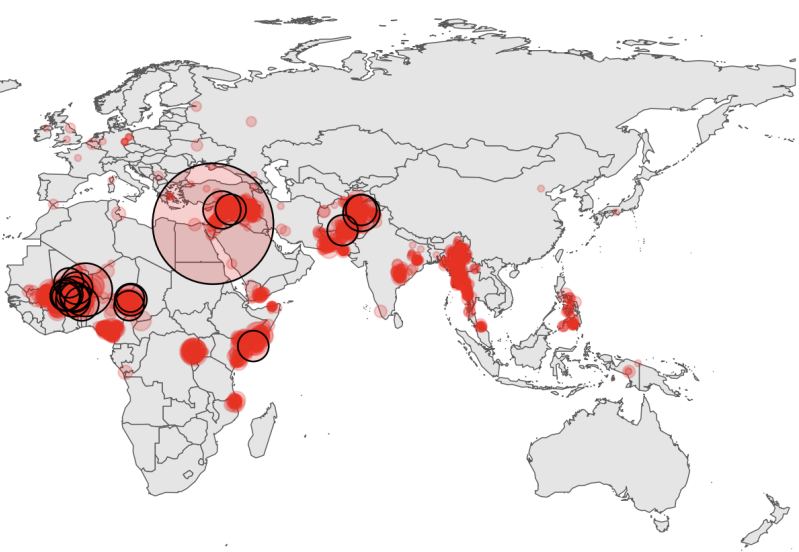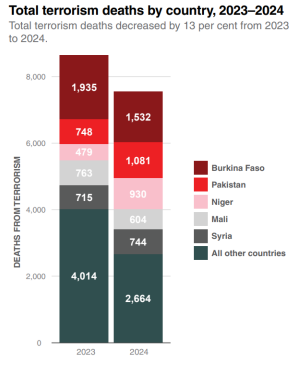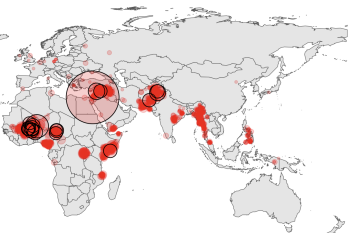
The Sahel continued as the region where most terrorist violence occurred in 2024, with Burkina Faso again the country with the most killings while Niger shot from 10th to fifth worst in the world, according to the 2025 Global Terrorism Index (GTI).
The Sahel accounted for over half of all deaths from terrorism in 2024 and 19 percent of all attacks, according to the GTI report, published by the Sydney, Australia-based Institute for Economics & Peace.
Despite a drop in terrorist violence in Burkina Faso, it was the country most prone to such violence for the second straight year, reflecting its steep deterioration since its rank of 114th in 2011.
“Burkina Faso, Mali and Niger, which were all ranked outside the top 30 in 2011, continue to be among the most affected by terrorism consistently since 2017,” the report states. “This underscores a geographic shift in the epicentre of terrorism away from the Middle East and towards the Sahel, with substantial implications for regional stability.”
Burkina Faso was followed by Pakistan and Syria as the three countries with the most terrorist violence, the majority of it perpetrated by Islamic extremist groups and much of targeting Christians. Besides Burkina Faso and Niger, other Sahel countries in the top 10 were Mali at fourth place and Cameroon at 10th. Rounding out the top 10, Somalia was ranked seventh, Israel eighth and Afghanistan ninth.
Burkina Faso maintained its top ranking despite attacks falling by 57 percent and deaths dropping by 21 percent. A fifth of all terrorism deaths globally were in Burkina Faso. Niger and Pakistan had the largest increases in deaths from terrorism, with increases of 94 percent and 45 percent respectively.
Terrorism-related deaths in Burkina Faso declined from 1,935 in 2023 to 1,532 in 2024, with attacks falling from 260 in 2023 to 111 in 2024, according to the report.
“This is the third consecutive year that over 1,000 people were killed in terrorist attacks in Burkina Faso,” the report states. “Northern and central-eastern Burkina Faso, near the country’s borders with Mali and Niger, experienced the most terror attacks, accounting for over two-thirds of all attacks in 2024.”
Of deaths in Burkina Faso, 682 occurred along the Niger border in Centre-Nord and Est, with the former region recording the highest death toll of the country’s 11 regions. Burkina Faso’s deadliest attack of 2024 took place in Centre-Nord, where Jamaat Nusrat Al-Islam wal Muslimeen (JNIM) militants launched a massive assault targeting both soldiers and civilians.
“The victims were engaged in digging defensive trenches for the army and the Volunteers for the Defense of the Homeland (VDP), a civilian armed group supporting Burkina Faso’s military efforts,” the report states. “Reports estimate the death toll to be between 200 and 600 deaths, with hundreds more injured.”
JNIM remained the most prominent terrorist group in Burkina Faso, claiming nearly half the country’s attacks in 2024. Islamic State (IS) activity in Burkina Faso declined last year, with the group claiming responsibility for only one attack, compared with eight the prior year – though attacks by both JNIM and IS may be significantly higher, as 55 percent of attacks and 35 percent of deaths in the country were attributed to “unknown jihadist groups.”
The Alliance of Sahel States, formed by Burkina Faso, Mali and Niger last year, represents a regional effort to combat terrorism following the withdrawal of French and United Nations troops.
“Despite these efforts, the security situation remains fragile, with reports of human rights abuses by both insurgents and government forces,” the GTI report states.
Burkina Faso’s military junta of Capt. Ibrahim Traoré has extended its rule until 2029, and international observers are concerned that further undemocratic governance could exacerbate instability that terrorist groups would exploit, according to the report.
“While the government has taken steps such as freezing the assets of individuals accused of financing terrorism and prioritizing counterterrorism efforts, it is unclear whether the recent decline in terrorism deaths signals lasting progress or a temporary fluctuation,” it states.
Islamic State and its affiliates remained the world’s deadliest terrorist group in 2024, being active in 22 countries, one more than in 2023, though deaths attributed to the group and its affiliates declined by 10 per cent, from 1,996 to 1,805.
Deterioration in Niger
Niger’s deterioration from 10th place to fifth was its worst ranking since the GTI’s inception.
“Niger recorded the largest increase, with deaths rising from 479 in 2023 to 930 in 2024,” the report states. “This is the country’s largest recorded death toll since the inception of the Index.”
The number of terrorist attacks in Niger rose to 101 in 2024, up from 62 the previous year. Killings of civilians in Niger increased almost threefold in 2024, while military deaths rose to 499 from 340 the prior year, accounting for more than half of all terrorism-related deaths in the country, the report notes.
“Niger now holds the highest military death toll from terrorism of any country in 2024,” it states. “Niger’s deadliest attack of 2024 occurred when over 300 gunmen killed 237 soldiers in an attack in the Tahoua region, near the Malian border. No group has claimed responsibility at the time of writing, but jihadists operate in the area. This attack was also the deadliest globally in 2024.”
Islamic insurgency in the Central Sahel severely impacted the Tillabéri region in the unstable tri-border area shared with Burkina Faso and Mali. JNIM activity in Niger saw a substantial increase in 2024, with the group claiming responsibility for 13 attacks that caused 109 deaths. IS also remained active, though attacks remained steady from the previous year, and deaths attributed to the group halved to 108.
“However, the full extent of activity by these groups remains unclear, as 75 percent of deaths and 66 per cent of attacks in 2024 were not claimed by any terrorist group,” the report states.
Political and security upheaval following a July 2023 coup created an environment ripe for exploitation by Islamic militant groups.
“Niger’s shift toward partnerships with Russia, accompanied by a decline in collaboration with Western allies, has contributed to a sharp rise in terrorist attacks and fatalities,” the report states. “Russian military instructors arrived in April 2024 to replace departing Western forces, but their efforts have been hindered by limited experience in the Sahel and a focus on supporting the ruling junta. The U.S. withdrawal in August 2024 further exacerbated the security vacuum, raising concerns about militant groups expanding their influence.”
The disruption of existing counterterrorism operations, combined with severed ties to Western powers such as France and the United States, have opened opportunities for groups such as JNIM and IS to escalate their activities in the region, the report states.
Trends

In other shifts, Nigeria’s ranking worsened from eighth to sixth, while Somalia remained at seventh place. Afghanistan dropped three places, from sixth to ninth, while Syria moved from fifth to third.
“Pakistan, Nigeria, Afghanistan and Somalia have consistently ranked among the 10 most affected countries since 2011, indicating ongoing challenges in addressing terrorism,” the report states.
In Nigeria, the GTI tracked only attacks by Boko Harm and Islamic State West Africa Province (ISWAP), leaving aside slaughters carried out by Fulani herdsmen, including the Fulani Ethnic Militia. From October 2019 to September 2023, “Armed Fulani Herdsmen” killed 11,948 civilians in Nigeria, compared with just 3,079 civilians killed by Boko Haram and ISWAP, according to an August 2024 report by the Observatory of Religious Freedom in Africa (ORFA). “Other Terrorist Groups,” commonly called “Fulani bandits,” killed an additional 12,039 civilians during the period.
In Pakistan, terrorism reached its highest level since 2014, moving the country to second place from fourth the prior year, according to the GTI. Terrorism-related deaths in Pakistan rose to 1,081.
“Terrorism has increased significantly in Pakistan since the Taliban’s rise to power in Afghanistan, with the number of attacks increasing fivefold since 2021,” the report notes. “The most recent surge in terrorism in Pakistan was primarily driven by increased activity from Tehrik-e-Taliban Pakistan (TTP), which is aligned with the Afghan Taliban.”
The four terrorist groups responsible for the most deaths in 2024 were Islamic State, Jamaat Nusrat Al-Islam wal Muslimeen, Tehrek-e-Taliban Pakistan (TTP) and Al-Shabaab. These four groups were responsible for 4,204 terrorism deaths, or 80 percent of those attributed to a specific group.
In 2014, these four groups were responsible for less than 40 per cent of terrorism deaths attributed to a group, highlighting the large global shifts in terrorism over the past decade. In 2014, most terrorism deaths were attributed to Boko Haram and the Taliban, which accounted for 17 percent and 5 percent of the total, according to the report.
IS and its affiliates remained the deadliest terrorist organization last year, responsible for 1,805 deaths in 22 countries. The four major terrorist groups continued to increase their activity, increasing their killings by 11 per cent to 4,204 compared with the prior year.
The number of countries suffering at least one terrorist incident increased from 58 to 66, the most countries affected since 2018. More countries deteriorated than improved for the first time in seven years, with 45 reporting a higher impact from terrorism, while only 34 showed improvement.
Deaths from terrorism globally fell to 7,555 last year, a 13 percent decline from the prior year. This reduction was due to the large spike the prior year from the Hamas Oct. 7 attack, otherwise deaths would have been approximately the same, the report states.
The number of terrorist attacks also declined, falling by 3 percent to 3,492. The drop was primarily driven by the 85 percent decrease in terrorist activity in Myanmar, where rebel groups previously carrying out terrorist attacks instead engaged in more conventional military warfare, according to the report.
“Excluding Myanmar, global terrorist attacks would have increased by 8 percent,” the report states.
Terrorism-related deaths in Myanmar fell from 356 in 2023 to 24 in 2024.
“As the crisis in Myanmar deepens, the decline in terrorism deaths is likely linked to the growing strength of rebel groups,” the report states. “With more powerful capabilities, these groups appear to rely less on terror-style attacks, focusing instead on conventional warfare against the junta.”
In Europe, terrorist incidents doubled to 67, including attacks by IS and Hamas.
“The resurgence of attacks was particularly notable in seven Western countries –Sweden, Australia, Finland, the Netherlands, Denmark and Switzerland, with Germany being the worst ranked nation at 27th on the Index,” the report states. “There are now seven Western countries ranked amongst the 50 most impacted countries on the GTI.”
At the same time, in the United States antisemitic and Islamophobic hate crimes escalated sharply following the Oct. 7, 2023 Hamas terrorist attack, with FBI-recorded incidents targeting the Jewish community rising by 270 percent in just two months, the report states.
“Similar patterns emerged in Europe and Australia, where attacks on synagogues were reported throughout the year,” it states.





